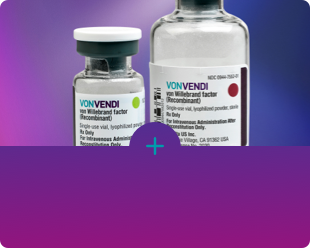


Treat bleeds as needed with on-demand treatment for VWD1
Indications
VONVENDI [von Willebrand factor (recombinant)] is indicated in adult and pediatric patients with von Willebrand disease (VWD) for1:
- On-demand treatment and control of bleeding episodes.
- Perioperative management of bleeding.
For adult patients only:
- Routine prophylaxis to reduce the frequency of bleeding episodes.
100% of adult patients using VONVENDI® [von Willebrand factor (Recombinant)] experienced on-demand treatment success1
- The primary efficacy assessment showed that the percentage of patients (n=18) with recombinant VWF treatment success was 100% (95% CI; 81.5 to 100)1
- This assessment excluded patients with gastrointestinal bleeds (n=2) and patients for whom the number of infusions to control a bleeding episode was estimated retrospectively (n=2)1
Over a period of 12 months, 22 adults with VWD and 192 bleeds were treated with VONVENDI with or without FVIII1,2,a

100% bleed control with an “Excellent” or “Good” rating1

97% Of all bleeds had an “Excellent” bleed resolution1

3% Of all bleeds had a “Good” bleed resolution1
*For one bleeding episode, a participant received VWF/FVIII complex; this episode was not included in the analysis.

Desktop Only
Study description
Hemostatic efficacy of VONVENDI was studied in a multicenter, open-label trial investigating various dosing strategies with or without rFVIII for on-demand treatment and control of bleeding in adults with von Willebrand disease. Initial bleeds were treated with VONVENDI plus rFVIII at a 1.3:1 ratio (30% more VONVENDI), followed by VONVENDI with or without rFVIII. rFVIII use was guided by FVlll:C levels to maintain plasma concentrations above 40 IU/dL (40%). A total of 192 bleeding episodes were treated with VONVENDI on-demand in 22/37 patients. Of the 22 patients, those with GI bleeds (n=2) and those in whom the number of infusions to control a BE was estimated retrospectively (n=2) were excluded from the primary analysis.1
Primary endpoint
- Number of study participants with treatment success for control of bleeding episodes1
- Treatment success was defined as a mean efficacy rating score of less than 2.5 for all bleeding episodes in a participant treated with VONVENDI1
Secondary endpoints included:
- The number of treated bleeding episodes with an efficacy rating of “Excellent” or “Good”1
- The number of infusions and number of units of VONVENDI administered with and without rFVIII per bleeding episode1
The efficacy rating was assessed on a 4-point scale (Excellent=1, Good=2, Moderate=3, None=4), with the investigator comparing the prospectively estimated number of infusions needed to treat the bleeding episode to the actual number of infusions administered.1
Excellent: Bleeds stopped with the estimated number of infusions or fewer.1
Good: Minor bleeds stopped with only 1-2 more infusions than estimated. Major bleeds stopped with less than 1.5 times the estimated number of infusions.1
A single infusion of VONVENDI resolved the majority of bleeds in adults

(157/192) OF BLEEDS TREATED WERE RESOLVED WITH 1 INFUSION (MEDIAN 1, RANGE 1-4)2
- Major/severe bleeds were resolved with a median of 2 infusions (range 1-3)2
The study protocol stipulated that the first dose of VONVENDI be administered together with recombinant factor VIII (rFVIII); however, according to dosing guidelines in the USPI, VONVENDI may be administered alone if an immediate rise in FVIII:C is not necessary, or if the baseline FVIII:C level is ≥40%.1,2
infusions per
bleed
n (%)
(n=122)
n (%)
(n=61)
n (%)
(n=7)
n (%)
(n=2)
n (%)
(n=192)
1 INFUSION TREATED AND CONTROLLED MUCOSAL, GASTROINTESTINAL, AND JOINT BLEEDS IN THE TRIAL1

MUCOSAL: MOUTH AND ORAL CAVITY
Median number of infusions: 1 (range 1-4)
Rated 100% “Excellent” (n=26)

MUCOSAL: NASOPHARYNGEAL
Median number of infusions: 1 (range 1-2)
Rated 98% “Excellent” and 2% “Good” (n=42)

MUCOSAL: GENITAL TRACT FEMALE
Median number of infusions: 1 (range 1-2)
Rated 97% “Excellent” and 3% “Good” (n=32)

GASTROINTESTINAL
Median number of infusions: 1 (range 1-2)
Rated 83% “Excellent” and 17% “Good” (n=6)

MUSCULOSKELETAL: JOINT
Median number of infusions: 1 (range 1-3)
Rated 97% “Excellent” and 3% “Good” (n=59)
n=number of bleeds assigned to this location.
Not all bleeds are included in this chart.
The study protocol stipulated that the first dose of VONVENDI be administered together with recombinant factor VIII (rFVIII); however, according to dosing guidelines, VONVENDI may be administered alone if an immediate rise in FVIII:C is not necessary, or if the baseline FVIII:C level is ≥40%.1,2
Summary of on-demand safety information in adult patients 2
6.4% (8/125) of adverse events (AEs) observed during the trial were considered to have a causal relationship to VONVENDI; they subsequently resolved.
- 75% (6/8) of AEs in 4 subjects were not serious:
- One patient experienced mild infusion-site paresthesia, moderate dysgeusia, and moderate tachycardia
- One patient experienced mild electrocardiogram T wave inversion
- One patient experienced mild generalized pruritus
- One patient experienced mild hot flush
One patient experienced 2 simultaneous serious AEs (chest discomfort and increased heart rate); symptoms improved after 10 minutes of oxygen therapy with a full recovery within 3 hours.
Review Safety Data
See the overall safety profile and adverse events for VONVENDI
Read Dosing by Indication
Prophylaxis, on-demand, and perioperative dosing for VONVENDI1
Contact a Takeda Rep
Get in touch with a Takeda representative in your area
References
- VONVENDI [von Willebrand factor (Recombinant)] Prescribing Information.
- Gill JC, Castaman G, Windyga J, et al. Hemostatic efficacy, safety, and pharmacokinetics of a recombinant von Willebrand factor in severe von Willebrand disease. Blood. 2015;126(17):2038-2046.
- Data on file, Takeda, Inc.



